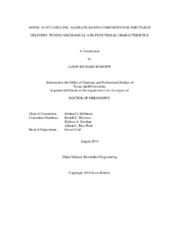| dc.description.abstract | The development of fully-implantable therapeutic and diagnostic devices represents a new paradigm in biomedical device design. However, designing materials that can perform as injectable matrices for the delivery of sensing and therapeutics chemistries while retaining control over sensor and drug release behaviors is a complex problem. The novel material described herein, microporous alginate composite (MPAC), allows for controllable in situ gelation—and hence enables injection—as well as encapsulation of functional elements such as sensing chemistries or therapeutics. As this material has never been described before, individual component materials, bulk mechanical and gelation properties, and sensing composite response characteristics were examined.
The use of polyelectrolyte multilayers (PEMs) in fabrication of MPACs resulted in a porous composite in which macromolecules and nanoparticles were retained within the pores, while allowing for free movement of these materials. Entrapped enzyme molecules were shown to react with diffusing substrates from outside the matrix, confirming the ability of materials from within the pores to interact with small molecules in the local environment.
Increasing numbers of PEMs used in composite fabrication was found to result in increased gelation times of hydrogels, while increasing particle concentration reduced gelation times. Changes in pH during MPAC gelation was also dependent on microsphere concentration and PEM numbers. After gelation, MPAC hydrogels immersed in water displayed complex swelling and stiffening behavior dependent on particle concentration and PEM numbers.
Oxygen-sensing MPAC hydrogels displayed minor PEM-dependent behavior, while glucose-sensing MPAC hydrogels displayed strong dependence on concentration and PEM numbers. As concentrations increased, sensitivities increased and analytical ranges decreased indicating cooperative behavior among enzyme-containing pores. Utilizing low permeability nanofilms, sensitivities and ranges of sensors could be modulated based upon the number of layers used in fabrication.
The development of this new composite system architecture permits an added level of control over injectable hydrogel physical and functional properties such as gelation time and sensor response characteristics. This added control could broaden the usage of alginate as an injectable material and lead to the development of a wide variety of new functional injectable devices. | en |


